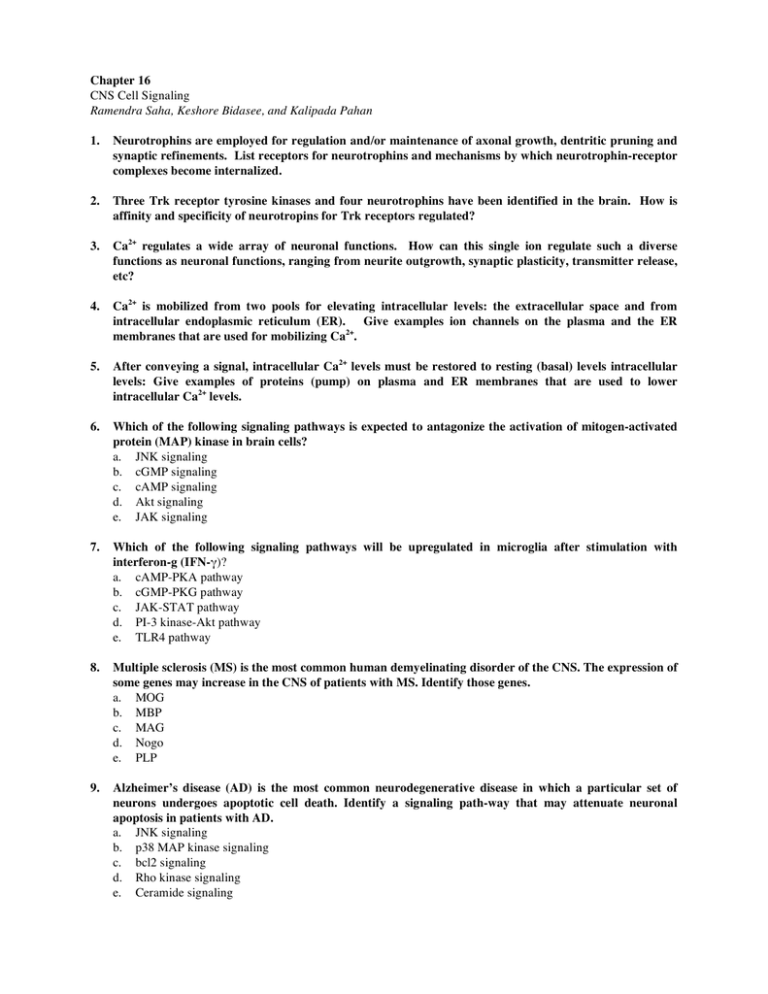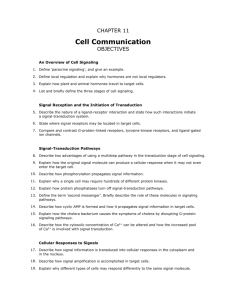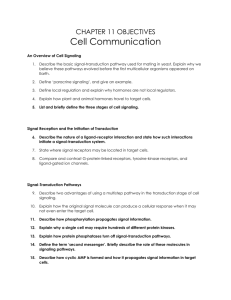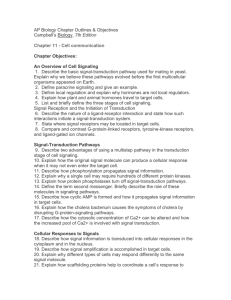Chapter 16 CNS Cell Signaling
advertisement

Chapter 16 CNS Cell Signaling Ramendra Saha, Keshore Bidasee, and Kalipada Pahan 1. Neurotrophins are employed for regulation and/or maintenance of axonal growth, dentritic pruning and synaptic refinements. List receptors for neurotrophins and mechanisms by which neurotrophin-receptor complexes become internalized. 2. Three Trk receptor tyrosine kinases and four neurotrophins have been identified in the brain. How is affinity and specificity of neurotropins for Trk receptors regulated? 3. Ca2+ regulates a wide array of neuronal functions. How can this single ion regulate such a diverse functions as neuronal functions, ranging from neurite outgrowth, synaptic plasticity, transmitter release, etc? 4. Ca2+ is mobilized from two pools for elevating intracellular levels: the extracellular space and from intracellular endoplasmic reticulum (ER). Give examples ion channels on the plasma and the ER membranes that are used for mobilizing Ca2+. 5. After conveying a signal, intracellular Ca2+ levels must be restored to resting (basal) levels intracellular levels: Give examples of proteins (pump) on plasma and ER membranes that are used to lower intracellular Ca2+ levels. 6. Which of the following signaling pathways is expected to antagonize the activation of mitogen-activated protein (MAP) kinase in brain cells? a. JNK signaling b. cGMP signaling c. cAMP signaling d. Akt signaling e. JAK signaling 7. Which of the following signaling pathways will be upregulated in microglia after stimulation with interferon-g (IFN-γ)? a. cAMP-PKA pathway b. cGMP-PKG pathway c. JAK-STAT pathway d. PI-3 kinase-Akt pathway e. TLR4 pathway 8. Multiple sclerosis (MS) is the most common human demyelinating disorder of the CNS. The expression of some genes may increase in the CNS of patients with MS. Identify those genes. a. MOG b. MBP c. MAG d. Nogo e. PLP 9. Alzheimer’s disease (AD) is the most common neurodegenerative disease in which a particular set of neurons undergoes apoptotic cell death. Identify a signaling path-way that may attenuate neuronal apoptosis in patients with AD. a. JNK signaling b. p38 MAP kinase signaling c. bcl2 signaling d. Rho kinase signaling e. Ceramide signaling 16. CNS Cell Signaling Ramendra Saha, Keshore Bidasee, and Kalipada Pahan 2 10. In normal human brain, cells are equipped to counteract inflammatory signaling transduced by proinflammatory cytokines. Which one of the following molecules is expected to counteract such inflammatory signaling? a. Ras signaling b. Rac signaling c. SOCS signaling d. Nitric oxide signaling e. Rho kinase signaling 11. One of the following molecules should play an active role in transcriptional upregulation of memory genes in the CNS. Identify that molecule. a. CREB b. bad c. bax d. HDAC e. Lingo 12. During glial activation, microglia release superoxide that may lead to oxidative stress in the CNS. Which one of the following enzymes should be actively involved in pro-ducing superoxide radicals during microglial activation? a. NADPH oxidase b. SOD c. Catalase d. Acyl-CoA oxidase e. Glucose oxidase 13. What is nuclear factor-κB (NF-κB)? Describe the status of NF-κB in normal brain cells. What are the possible signaling mechanisms for the activation of NF-κB? How is the activation of NF-κB related to neuroinflammatory diseases like MS and meningitis? 14. What is a mitogen? How do the mitogens generally signal for the abnormal cell growth? How can you possibly inhibit mitogen-induced abnormal cell growth? 15. Is mitogen-induced signaling involved in the pathogenesis of brain cancer? If yes, then explain with possible reasons and therapeutic targets. 16. CNS Cell Signaling Ramendra Saha, Keshore Bidasee, and Kalipada Pahan 3 Answers 1. Neurotrophins are employed for regulation and/or maintenance of axonal growth, dentritic pruning and synaptic refinements. List receptors for neurotrophins and mechanisms by which neurotrophin-receptor complexes become internalized. Trk receptor tyrosine kinases and p75 neurotrophin receptor are the receptors for neurotrophins Receptors for neurotrophins are TrK A, TrkB and TrkC. The neurotrophin-Trk receptor complex is internalized by four mechanistically diverse and highly regulated pathways: (i) macropinocytosis; (ii) clathrin-mediated endocytosis; (iii) caveolae-mediated endocytosis; (iv)Pincher-mediated endocytosis. The kinase activity of Trk is probably required for receptor internalization. 2. Three Trk receptor tyrosine kinases and four neurotrophins have been identified in the brain. How is affinity and specificity of neurotropins for Trk receptors regulated? Binding of neurotrophins is the primary mechanism by which Trk receptors are activated but the affinity and specificity of neurotrophins for Trk receptors is regulated by p75NTR. For example, the association of p75NTR with Trk receptors induces a conformation that has high affinity for NGF. Association of p75NTR also enhances the discrimination of Trk for their preferred neurotrophin ligand. 3. Ca2+ regulates a wide array of neuronal functions. How can this single ion regulate such a diverse functions as neuronal functions, ranging from neurite outgrowth, synaptic plasticity, transmitter release, etc? Ca2+ can regulate such diverse functions as neuronal functions, ranging from neurite outgrowth, synaptic plasticity, transmitter release, etc by virtue of the quantity of release (amplitude), where in the neuron it is release (spatial location) and for how long it was release (time). 4. Ca2+ is mobilized from two pools for elevating intracellular levels: the extracellular space and from intracellular endoplasmic reticulum (ER). Give examples ion channels on the plasma and the ER membranes that are used for mobilizing Ca2+. Ca2+ can be mobilized from external stores (extracellular space) following activation of ligand-gated channel (e.g., NMDA and P2X receptors), voltage-operated Ca2+ channels (L-type, T-type and N-type Ca2+ channels) or from internal stores (endoplasmic reticulum) via activation of inositol 1,4,5-trisphosphate receptors (InsP3R) and ryanodine receptors (RyR). 5. After conveying a signal, intracellular Ca2+ levels must be restored to resting (basal) levels intracellular levels: Give examples of proteins (pump) on plasma and ER membranes that are used to lower intracellular Ca2+ levels. After the physiological task is completed, the influxed Ca2+ is removed from the cytoplasm by plasma membrane bound Ca2+-ATPases (PMCA) and Na+-Ca2+ exchangers. Ca2+ that are mobilized from the endoplasmic reticulum are returned to the stores via sarco(endo)plasmic reticulum Ca2+-ATPase (SERCA). 6. c 7. e 8. c and d 9. c 10. c 11. a 12. a






